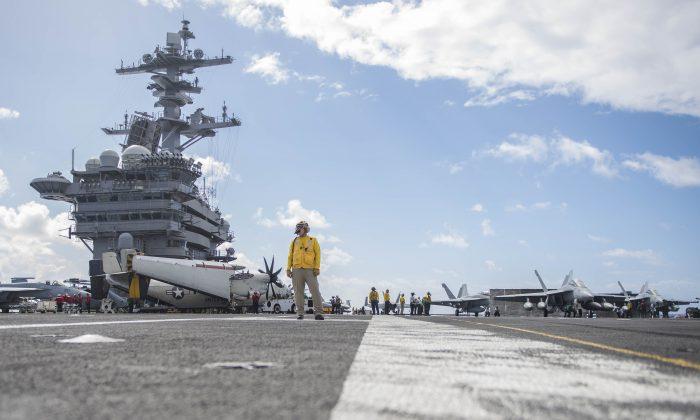The U.S Pacific Command added two more aircraft carriers and their accompanying strike groups to the 7th Fleet this week, temporarily giving U.S. forces a significant increase in firepower near the Korean Peninsula.
The Pacific Command will also see its first deployment of F-35A stealth fighter jets in early November.
The Aircraft carrier USS Theodore Roosevelt and its accompanying strike group entered the 7th Fleet area of operations (AOO) on Monday, Oct. 25, transferring its task force designation from the 5th Fleet to the seventh.
The Navy said the Roosevelt and its strike group will “conduct maritime security operations, theater security cooperation, and port visits as part of the U.S. Navy’s ongoing presence in the Indo-Asia-Pacific region.
The Roosevelt’s strike group comprises the guided-missile cruiser the USS Bunker Hill, and three guided-missile destroyers: the USS Halsey, the USS Preble, and the USS Sampson.
The group also includes three squadrons of F-18 variant super hornets, the VMFA 312 Marine Fighter Attack Squadron, Electronic Attack Squadron (VAQ) 139, Airborne Early Warning Squadron (VAW) 116, Helicopter Sea Combat Squadron (HSC) 6, Helicopter Maritime Strike Squadron (HSM) 73, and Fleet Logistics Support Squadron (VRC) 30.
“USS Theodore Roosevelt is prepared to carry out the full spectrum of possible missions, from humanitarian relief to combat operations,” said Capt. Carlos Sardiello, Theodore Roosevelt’s commanding officer.
“When a carrier leaves on deployment, we have to be ready for anything,” he said.
The Roosevelt and its strike group are on route to the 5th Fleet’s area of responsibility in the Middle East but fall under the authority of Pacific Command as they pass through its jurisdiction.
“That’s just standard protocol,” said Nicole Schwegman with Pacific Fleet public affairs.
There is no clear timeline of when the Roosevelt and its strike group will leave Pacific Command’s area of responsibility and those assets could be tasked with other operations while in the region.
The Pacific Fleet will also see the return of the USS Nimitz aircraft carrier and its strike group, which had been conducting operations with the 5th Fleet in the Middle East as part of Operation Inherent Resolve to wipe out ISIS.
The Nimitz comes with the guided-missile cruiser the USS Princeton, and four guided-missile destroyers: the USS Howard, USS Shoup, USS Pinckney, and USS Kidd, as well as its own fighter jet squadrons, electronic warfare squadron, and more.
The Nimitz and its strike group are on route back to the United States, said Schwegman, but also fall under the authority of Pacific Command as they pass through the area.
For the time being, the two aircraft carriers and their strike groups join the USS Ronald Reagan Carrier Strike Group, which has been conducting training operations around the Korean Peninsula and went to port in Busan, South Korea on Saturday, Oct. 21.
Like the other two aircraft carriers, the Reagan has its own strike group made up of a long list of ships, fighter jets, and other aircraft.
The Reagan’s carrier strike group specializes in training and material readiness and has been focusing on bilateral training exercises and is to increase the readiness of U.S. and Republic of Korea (ROK) forces.
Meanwhile, the first operational deployment of the U.S. Air Force’s F-35A Lightning II fighters are also set to deploy to Japan.
The Pacific Command, which oversees the Pacific Fleet and Pacific Air Force, will see approximately 300 airmen and 12 F-35A Lightning IIs join its Kadena Air Base in Japan for a six-month rotation in early November.
“The F-35A gives the joint warfighter unprecedented global precision attack capability against current and emerging threats while complementing our air superiority fleet,” said Gen. Terrence J. O’Shaughnessy, Pacific Air Forces commander.
“The airframe is ideally suited to meet our command’s obligations, and we look forward to integrating it into our training and operations,” he said.
This story was updated from an earlier version to indicate the USS Theodore Roosevelt and USS Nimitz are temporarily under Pacific Command.






Friends Read Free